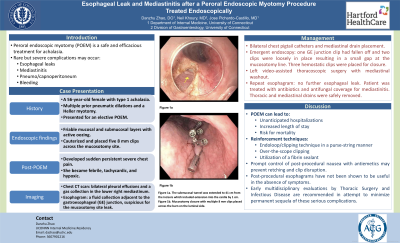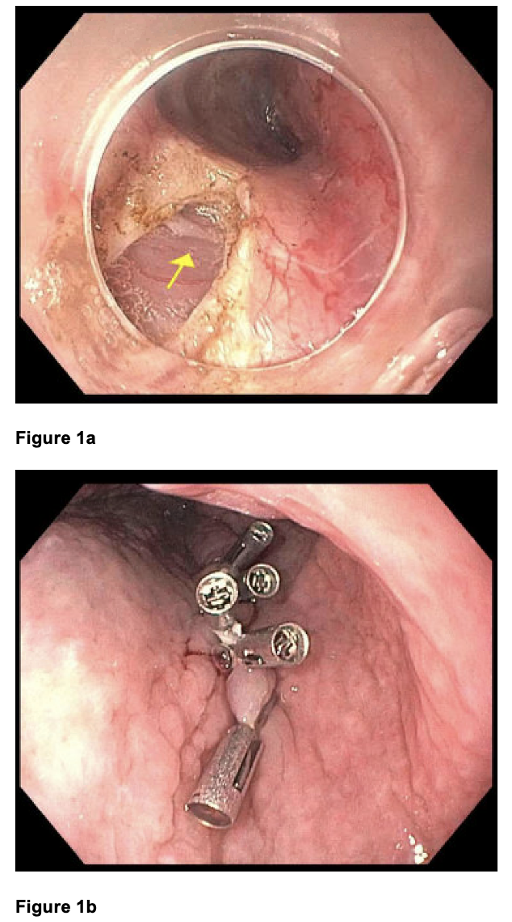Monday Poster Session
Category: Esophagus
P2240 - Esophageal Leak and Mediastinitis After Peroral Endoscopic Myotomy Treated Endoscopically
Monday, October 28, 2024
10:30 AM - 4:00 PM ET
Location: Exhibit Hall E

Has Audio

Danzhu Zhao, DO
University of Connecticut Health Center
WEST HARTFORD, CT
Presenting Author(s)
Danzhu Zhao, DO1, Neil Khoury, MD2, Jose Pichardo-Castillo, MD3
1University of Connecticut Health Center, Farmington, CT; 2UConn Health, Hartford, CT; 3Hartford Hospital, Hartford, CT
Introduction: Peroral endoscopic myotomy (POEM) is a safe and efficacious treatment for achalasia; however, rare but severe complications such as esophageal leaks or mediastinitis may occur. We present a patient who underwent POEM complicated by an esophageal leak, bilateral pleural effusions and mediastinitis.
Case Description/Methods: A 56-year-old female with type 1 achalasia status post multiple prior pneumatic dilations and a Heller myotomy, presented for an elective POEM. Endoscopic findings revealed friable mucosal and submucosal layers with active oozing requiring cautery and placement of five 8 mm clips across the mucosotomy site.
She developed sudden severe chest pain and persistent retching after the procedure. She became febrile, tachycardic, and hypoxic. A chest CT scan was obtained and showed bilateral pleural effusions and a gas collection in the lower right mediastinum. An esophagram demonstrated a fluid collection adjacent to the gastroesophageal (GE) junction, suspicious for the mucosotomy site leak. Patient required bilateral chest pigtail catheters and mediastinal drain placement. She subsequently underwent an emergent endoscopy which revealed that one GE junction clip had fallen off and two clips were loosely in place resulting in a small gap at the mucosotomy line. Three hemostatic clips were placed for closure. She required a left video-assisted thoracoscopic surgery with mediastinal washout. Repeat esophagram did not show further esophageal leak. Patient was treated with antibiotics and antifungal coverage for mediastinitis. Her clinical course gradually improved. Thoracic and mediastinal drains were safely removed. She was discharged home successfully.
Discussion: Although uncommon, POEM complications such as esophageal leak and mediastinitis can lead to unanticipated hospitalizations, increased length of stay and risk for mortality. Prophylactically reinforcing closure may benefit patients with abnormal appearing esophageal mucosa. Several reinforcement techniques have been described in the literature, including endoloop/clipping technique in a purse-string manner, over-the-scope clipping and utilization of a fibrin sealant. Prompt control of post-procedural nausea with antiemetics may help prevent retching and clip disruption. Post-procedural esophagrams have not been shown to be useful in the absence of symptoms. Early multidisciplinary evaluations by Thoracic Surgery and Infectious Disease are recommended in attempt to minimize permanent sequela of these serious complications.

Disclosures:
Danzhu Zhao, DO1, Neil Khoury, MD2, Jose Pichardo-Castillo, MD3. P2240 - Esophageal Leak and Mediastinitis After Peroral Endoscopic Myotomy Treated Endoscopically, ACG 2024 Annual Scientific Meeting Abstracts. Philadelphia, PA: American College of Gastroenterology.
1University of Connecticut Health Center, Farmington, CT; 2UConn Health, Hartford, CT; 3Hartford Hospital, Hartford, CT
Introduction: Peroral endoscopic myotomy (POEM) is a safe and efficacious treatment for achalasia; however, rare but severe complications such as esophageal leaks or mediastinitis may occur. We present a patient who underwent POEM complicated by an esophageal leak, bilateral pleural effusions and mediastinitis.
Case Description/Methods: A 56-year-old female with type 1 achalasia status post multiple prior pneumatic dilations and a Heller myotomy, presented for an elective POEM. Endoscopic findings revealed friable mucosal and submucosal layers with active oozing requiring cautery and placement of five 8 mm clips across the mucosotomy site.
She developed sudden severe chest pain and persistent retching after the procedure. She became febrile, tachycardic, and hypoxic. A chest CT scan was obtained and showed bilateral pleural effusions and a gas collection in the lower right mediastinum. An esophagram demonstrated a fluid collection adjacent to the gastroesophageal (GE) junction, suspicious for the mucosotomy site leak. Patient required bilateral chest pigtail catheters and mediastinal drain placement. She subsequently underwent an emergent endoscopy which revealed that one GE junction clip had fallen off and two clips were loosely in place resulting in a small gap at the mucosotomy line. Three hemostatic clips were placed for closure. She required a left video-assisted thoracoscopic surgery with mediastinal washout. Repeat esophagram did not show further esophageal leak. Patient was treated with antibiotics and antifungal coverage for mediastinitis. Her clinical course gradually improved. Thoracic and mediastinal drains were safely removed. She was discharged home successfully.
Discussion: Although uncommon, POEM complications such as esophageal leak and mediastinitis can lead to unanticipated hospitalizations, increased length of stay and risk for mortality. Prophylactically reinforcing closure may benefit patients with abnormal appearing esophageal mucosa. Several reinforcement techniques have been described in the literature, including endoloop/clipping technique in a purse-string manner, over-the-scope clipping and utilization of a fibrin sealant. Prompt control of post-procedural nausea with antiemetics may help prevent retching and clip disruption. Post-procedural esophagrams have not been shown to be useful in the absence of symptoms. Early multidisciplinary evaluations by Thoracic Surgery and Infectious Disease are recommended in attempt to minimize permanent sequela of these serious complications.

Figure: Figure 1a. The starting myotomy which was extended to 41 cm from the incisors.
Figure 1b. Mucosotomy closure with five 8 mm clips placed across the burn on the luminal side of the esophagus.
Figure 1b. Mucosotomy closure with five 8 mm clips placed across the burn on the luminal side of the esophagus.
Disclosures:
Danzhu Zhao indicated no relevant financial relationships.
Neil Khoury indicated no relevant financial relationships.
Jose Pichardo-Castillo indicated no relevant financial relationships.
Danzhu Zhao, DO1, Neil Khoury, MD2, Jose Pichardo-Castillo, MD3. P2240 - Esophageal Leak and Mediastinitis After Peroral Endoscopic Myotomy Treated Endoscopically, ACG 2024 Annual Scientific Meeting Abstracts. Philadelphia, PA: American College of Gastroenterology.
